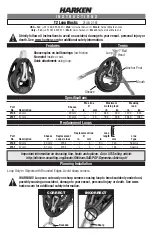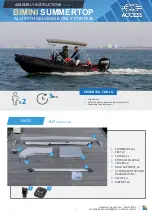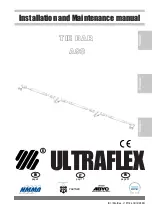
Specifications
27
2.0 Service
Brake Drum Inspection:
There are two areas of the brake drum that are subject to wear and require inspection. These two areas are the drum surface where the
brake shoes make contact during stopping and the armature surface where the magnet contacts (only in electric brakes).
The drum surface should be inspected for excessive wear or heavy scoring. If worn more than .020” oversized, or if the drum has worn
out of round by more than .015”, then the drum surface should be turned. If scoring or other wear is greater than .090” on the diameter,
the drum must be replaced. When turning the drum surface, the maximum re-bore diameter for a 12” brake drum is 12.090”
The machined inner surface of the brake drum that contacts the brake magnet is called the armature surface. If the armature surface is
scored or worn unevenly, it should be refaced to a 120 micro inch finish by removing not more than .030” of material. To insure proper
contact between the armature face and the magnet face, the magnets should be replaced whenever the armature surface is refaced
and the armature surface should be refaced whenever the magnets are replaced.
2.11 Daily Service (5 -10 Hours of Use)
NOTE: J&M recommends the following service to be performed daily (every 5-10 hours of use)
1.
Grease the conveyor bearings every 10 hours. Use only two pumps of grease per bearing
NOTE: Over lubrication of these bearings will result in premature failure.
NOTE: The conveyor has 4 bearings that need greased (2 at each end).
2. Check your belt for proper tracking every 10 hours
of use and before every season. For steps to properly track your belt see section 2.7.
NOTE: When checking the belt for tracking you should empty out the clean-out door (Figure 2.4).
3.
Check hydraulic oil level.
4.
Inspect for oil leaks and repair as appropriate.
5.
Check all hoses, fittings, bolts, and hardware to make sure that they are secure and properly tightened.
6.
Check engine oil level. See Engine operator’s manual for details on oil levels, oil types and service intervals.
7.
Check Speed Tender breaks and lights before towing.
8.
Check the Speed Tender periodically for cracks in welds and for other structural damage. Have cracked welds fixed immediately.
NOTE: Failure to have cracked welds fixed immediately could result in extensive damage to
the Speed Tender and greatly reduce its life.
9.
Make sure tires are properly inflated (See page 19).
10.
Make sure wheel lug nuts are properly torqued (See page 19).
11.
Make sure that the conveyor hopper guard is in place. Do not remove.
12.
Clean out the Conveyor at the end of every day of use (Section 1.8).
2.12 End of the Year Service
IMPORTANT: When the Speed Tender is not going to be used for a length of time, J & M recommends that you store the
Speed Tender in a dry, protected place. Leaving your Speed Tender outside and open to the weather will shorten its life.
1.
Grease the conveyor bearings. Use only two pumps of grease per bearing.
NOTE: Over lubrication of these bearings will result in premature failure.
NOTE: The conveyor has four bearing that need greased (two at each end).
2.
Grease pivot points on boom arm before storage.
3.
The wheel bearings need to be cleaned, inspected, repacked, and adjusted. Use a number 2 wheel bearing grease to repack the
bearings.
4.
Inspect and service the brakes (magnets and shoes). They must be changed when they become worn or scored, thereby
preventing inadequate vehicle braking. Clean the backing plate, magnet arm, magnet, and brake shoes. Make certain that
all the parts removed are replaced in the same brake and drum assembly. Inspect the magnet arm for any loose or worn
parts. Check shoe return springs, hold down springs, and adjuster springs for stretch or deformation, replace as needed.
















































